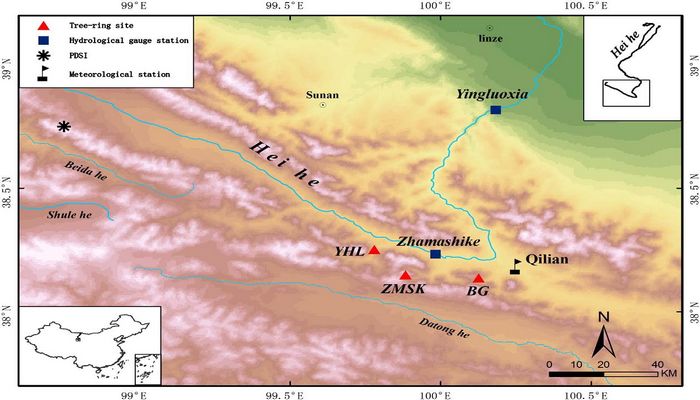
(Map showing tree-ring sampling sites in the Qilian Mountains. Triangles denote tree-ring sites of Zhamashike (ZMSK), Youhulou (YHL) and Binggou (BG). Black star denotes
the location of the nearest PDSI gridpoint to the tree-ring sampling area.)(image/Global and Planetary Change)
The research of intensified pluvial conditions during the twentieth century in the inland Heihe River Basin in arid northwestern China over the past millennium was accomplished recently by the researchers of Cold and Arid Regions Environmental and Engineering Research Institute. The significance of this research is that it can serve as a robust data basis so as to make more scientific and more reasonable water allocation alternatives for the Heihe River Basin. Furthermore, it emphasizes the perspective that long-term planning of water resource management is particularly important in order to cope with low streamflow conditions which occurred frequently in the past, which are expected to occur in the future.
It is learned that past streamflow variability is of special significance in the inland river basin,the Heihe River Basin in arid northwestern China, where water shortage is a serious environmental and social problem. However, the current knowledge of issues related to regional water resources management and long-term planning and management is limited by the lack of long-term hydro-meteorological records. Here we present a 1009-year annual streamflow (August–July) reconstruction for the upstream of the Heihe River in the arid northwestern China based on a well-replicated Qilian juniper (Sabina przewalskii Kom.) ring-width chronology. This reconstruction accounts for 46.9% of the observed instrumental streamflow variance during the period 1958–2006. Considerable multidecadal to centennial flow variations below and above the longterm average are displayed in the millennium streamflow reconstruction. These periods 1012–1053, 1104–1212, 1259–1352, 1442–1499, 1593–1739 and 1789–1884 are noteworthy for the persistence of low-level river flow, and for the fact that these low streamflow events are not found in the observed instrumental hydrological record during the recent 50 years. The 20th century witnessed intensified pluvial conditions in the upstream of the Heihe River in the arid northwestern China in the context of the last millennium.Comparison with other long-term hydrological reconstructions indicates that the intensification of the hydrological cycle in the twentieth century from different regions could be attributable to regional to largescale temperature increase during this time.
The study was jointly funded by the National Basic Research Program of China (973 Program) (No.2009CB421306), the Chinese Academy of Sciences (CAS) 100 Talents Project (29082762) and the NSFC (Grant No. 40671196, 40871091).

